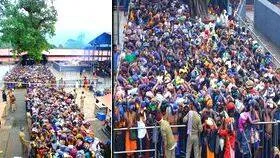

As the annual pilgrimage season approaches, the Sabarimala temple—one of the most revered shrines in India—once again braces for an overwhelming influx of devotees. With millions visiting the sacred hill shrine each year, the need for improved infrastructure has become more urgent than ever. However, the unique challenges posed by Sabarimala’s location in a protected forest area present significant legal and logistical hurdle, particularly when it comes to securing land for expansion.
One of the most pressing issues faced by the temple is the sheer difficulty pilgrims face in gaining a brief glimpse of Lord Ayyappa. Many devotees, after enduring long and arduous journeys from across the country, leave Sabarimala without even a moment’s darshan of the deity, due to the massive crowds and inadequate crowd control systems. Year after year, promises of better arrangements are made, yet no lasting solution has been implemented to ensure smooth darshan for all, similar to the crowd management systems in other major temples across the country.
The Travancore Devaswom Board, which oversees the temple's administration, is now considering a new crowd control mechanism. The proposed plan involves constructing a flyover near the Sannidhanam to facilitate more efficient movement of devotees. The idea is to allow pilgrims arriving from both sides of the flagpole to use this flyover for darshan, thereby reducing the long waiting times. This system is expected to undergo trial in the coming months and if successful, it could be fully implemented by the next Makaravilakku season. Such a system, if executed well, could significantly ease the ordeal of waiting in endless queues.
In the past, similar reforms have been discussed, but no concrete action was taken. Had these initiatives been set in motion earlier, the upcoming pilgrimage season could have benefitted. Alongside this, there are also plans to develop alternative routes, such as diverting devotees directly to Malikappuram after darshan, which could further ease congestion at the main temple.
A key factor contributing to the crowding is the seasonal nature of Sabarimala pilgrimages. Unlike other temples open year-round, Sabarimala experiences a concentrated rush during specific periods, leading to unmanageable crowds. Adding to this, the preservation of age-old traditions has created barriers to introducing certain reforms. Nevertheless, it remains crucial to explore every avenue for expanding the facilities within the existing framework.
Another pressing concern is the condition of the roads leading to Sabarimala. Heavy monsoon rains have left many of these roads in disrepair. Despite the substantial amounts of money spent on road maintenance every year, the recurring problem of poor-quality construction means that new repairs are needed for every pilgrimage season. This year is no different, with stretches of the road damaged and in need of urgent attention. The solution lies not in temporary fixes but in building roads that can withstand the region's severe weather conditions.
There is also a growing demand for improving facilities at Sabarimala, Pampa and Nilakkal. For instance, there is a proposal to create a two-story pavement to provide resting space for pilgrims coming from Pampa to the Sannidhanam. Given the massive crowds, such ideas should be given serious consideration. However, time is of the essence—renovation work and infrastructure upgrades must be completed swiftly before the next pilgrimage season begins.